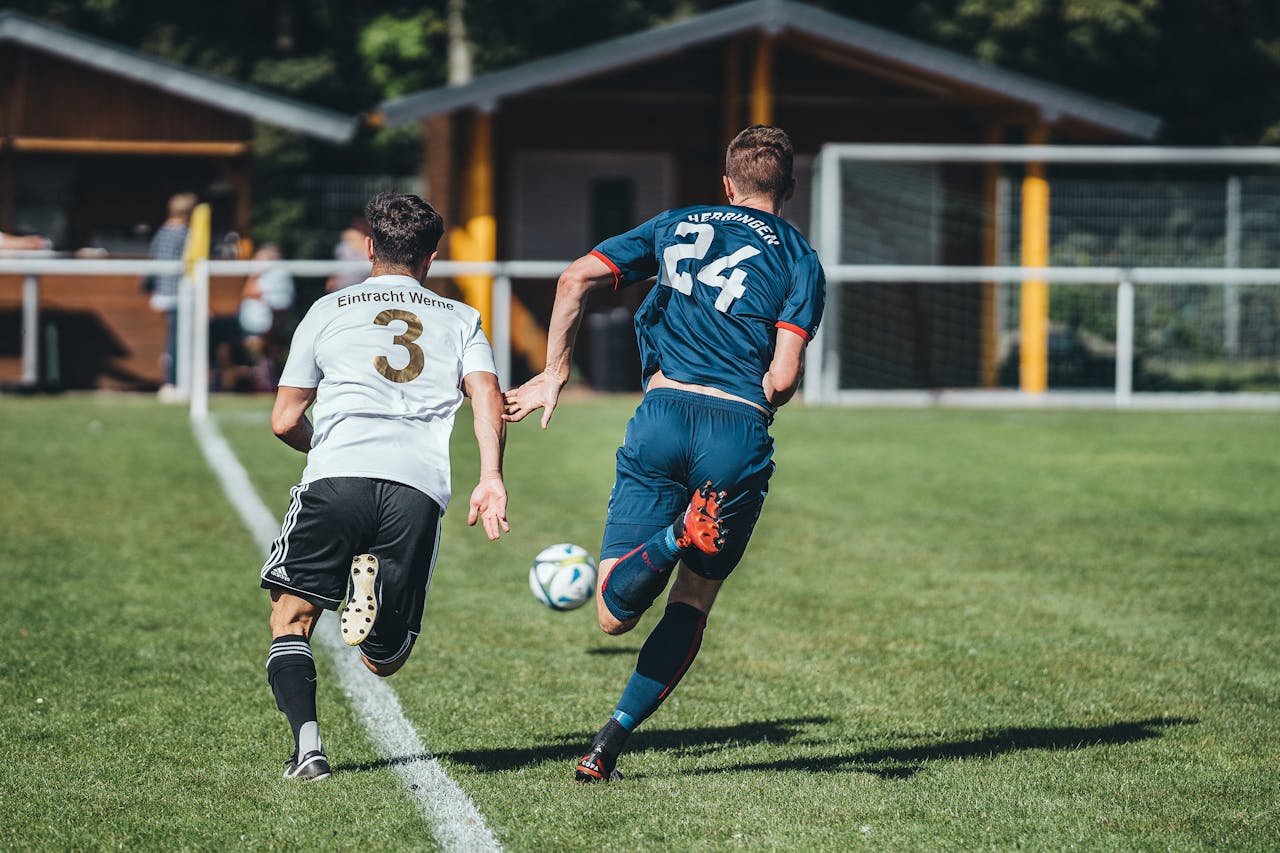Soccer is a high-intensity sport that demands a lot from your body. Whether you’re sprinting down the pitch, defending against a fast attacker, or making those long runs into the box, stamina is key to staying competitive. But how do you build stamina for soccer in a way that will keep you at your best throughout the game?
In this article, we’ll cover some proven training tips to help you improve your endurance on the field, so you can keep up with the action without getting winded. We’ll break it down with simple steps that anyone can follow, regardless of their fitness level. Ready to run harder, last longer, and dominate your game? Let’s get started!
Understanding Stamina in Soccer
Stamina is more than just being able to run a few miles without stopping. In soccer, stamina involves your ability to sustain high-intensity efforts over the course of a 90-minute match. This means it’s not just about endurance, but also your ability to recover quickly and stay sharp, even when you’re tired.
There are two main types of stamina that soccer players need to focus on:
- Aerobic Stamina: This is your body’s ability to sustain longer, lower-intensity activity, like jogging or tracking back to defend.
- Anaerobic Stamina: This refers to your ability to perform short bursts of high-intensity activity, such as sprinting or making a quick tackle.
Improving both types of stamina will ensure you can handle every aspect of the game, from defending to attacking, without burning out too quickly.
Why is Stamina Important in Soccer?
Soccer matches are fast-paced and full of sudden movements. Whether you’re sprinting, jogging, or stopping on a dime, your body needs to be able to handle these fluctuations in intensity. Without good stamina, it’s easy to get tired quickly and lose focus on the field, leading to missed opportunities or sloppy play.
Good stamina allows you to:
- Keep up with the speed of the game without feeling exhausted.
- Make sharper decisions even when fatigued.
- Stay physically capable of making plays until the final whistle.
- Reduce the risk of injury, as fatigued muscles are more prone to injury.
The more fit and conditioned you are, the better you’ll perform over the long haul of a match. That means less frustration, more control, and a better all-around game.
How to Build Aerobic Stamina for Soccer
Aerobic stamina is all about how well your body can use oxygen to fuel lower-intensity activities. Building this kind of stamina helps you with those long runs, tracking back on defense, and maintaining a steady pace throughout the game.
Long, Steady-State Runs
One of the most effective ways to build aerobic stamina is through long, steady-state runs. These runs should be at a moderate pace—something you can maintain for a longer period without getting winded. Try to aim for 30-45 minute runs, three to four times a week, at a pace that’s just below your “comfort zone” but not so hard that you’re gasping for air.
As you get more accustomed to this, you can gradually increase the time or distance of your runs, making it harder as your stamina improves.
Fartlek Training
Fartlek training, which means “speed play” in Swedish, involves alternating between periods of faster running and slower recovery. This helps mimic the intensity changes you’ll experience in a soccer match, where you might sprint, jog, or walk in quick succession.
Start with a warm-up, then alternate between 30-second sprints and 90 seconds of jogging or walking. Do this for 20-30 minutes. This type of training is excellent for improving both your aerobic and anaerobic stamina since it forces your body to adapt to changing speeds.
Interval Training
Interval training is another great way to build aerobic stamina. This involves alternating between high-intensity work and recovery periods. For soccer, this could mean sprinting for 30 seconds, followed by a 1-minute jog or walk. You can adjust the work-to-rest ratio depending on your fitness level.
Interval training helps train your body to recover quickly between efforts, so you can keep your performance level high throughout the match. This is especially useful for soccer, where you have to switch between jogging, sprinting, and walking many times during a game.
Improving Anaerobic Stamina for Soccer
Anaerobic stamina is essential for the quick bursts of energy you need for activities like sprinting, making tackles, or chasing down an opponent. Here are some ways to improve anaerobic stamina:
Sprints and Agility Drills
To build anaerobic stamina, you need to train your body to handle high-intensity efforts. Sprinting and agility drills are excellent ways to do this.
- Short Sprints: Do 5-10 sprints of 20-40 meters at full intensity, resting for 60 seconds between each sprint.
- Agility Ladder Drills: Use an agility ladder to perform quick footwork drills, helping you improve your reaction time and speed.
These exercises help improve your body’s ability to quickly produce energy for short bursts, which is exactly what you need for fast-paced soccer matches.
High-Intensity Interval Training (HIIT)
HIIT workouts are a great way to improve anaerobic stamina. These workouts involve alternating between periods of intense effort and rest. For example, you might do 30 seconds of intense exercise (like jumping jacks or burpees), followed by 1 minute of rest. The high-intensity bursts challenge your body’s anaerobic system, which is crucial for soccer performance.
HIIT workouts are short but effective, and they can be done 2-3 times per week. As you get stronger, you can increase the number of rounds or reduce the rest time to push yourself further.
Maintaining Stamina During the Season
Once you’ve built up your stamina, it’s important to maintain it throughout the season. That means you’ll need to incorporate regular training into your routine, even if you’re not in the off-season. Here’s how you can do it:
- Continue Long Runs and Intervals: Keep doing long runs and interval training, but scale back the intensity if you’re already playing in matches regularly.
- Stay Active Between Matches: Engage in light activities like swimming, cycling, or even walking to keep your body active without overtraining.
- Rest and Recovery: Don’t underestimate the power of rest. Your body needs time to recover, especially after intense games or workouts.
By consistently working on your stamina, you’ll stay at the top of your game and be ready for whatever the match throws at you.
Nutrition and Hydration: Fueling Your Stamina
Building stamina isn’t just about training—it’s also about fueling your body properly. Your energy levels on the pitch are heavily influenced by your diet and hydration. Without proper fuel, even the best training can fall short. Let’s take a look at how to support your stamina-building efforts with the right nutrition and hydration.
Carbohydrates: The Key Fuel for Soccer Players
Soccer is a sport that relies heavily on quick bursts of energy, and carbohydrates are your body’s primary source of fuel for that. When you eat carbohydrates, they get broken down into glucose, which your muscles use during intense activity.
To keep your energy levels high, it’s important to include plenty of healthy carbohydrates in your diet. Good sources include:
- Whole grains (brown rice, whole wheat pasta, quinoa)
- Fruits (bananas, apples, berries)
- Vegetables (sweet potatoes, carrots, spinach)
- Legumes (beans, lentils)
Make sure you’re eating a balanced amount of carbs before and after your workouts, as well as during your training sessions to keep your stamina levels up.
Protein for Muscle Recovery
While carbohydrates are key for fueling your stamina, protein is essential for muscle recovery. After long runs or intense drills, your muscles need protein to repair and rebuild. Eating protein-rich foods helps your body recover faster, so you can train harder and longer.
Try to include protein in every meal, with sources like:
- Lean meats (chicken, turkey, lean beef)
- Fish (salmon, tuna, cod)
- Eggs and dairy products (yogurt, cheese)
- Plant-based protein (tofu, tempeh, quinoa)
Aim for about 1.2 to 2 grams of protein per kilogram of body weight, especially if you’re involved in intense training or matches.
Hydration: Don’t Let Dehydration Drag You Down
Hydration is crucial for stamina. Even mild dehydration can reduce your performance, leading to fatigue and poor decision-making on the field. During training and games, it’s important to drink enough water to stay hydrated and maintain optimal performance.
For most people, drinking water is enough to stay hydrated during practice, but for intense sessions or long matches, electrolyte drinks can help replace lost minerals like sodium, potassium, and magnesium.
Drink water regularly throughout the day, not just during training or matches. Aim for at least 2-3 liters of water daily, and make sure to hydrate before and after exercise.
Sleep and Recovery: Let Your Body Recharge
Good sleep is just as important as good training when it comes to building stamina. This is when your body does the majority of its recovery work. Without enough rest, your muscles don’t have the time they need to repair and grow stronger. Plus, lack of sleep can lead to fatigue and poor decision-making on the pitch, which will affect your stamina over time.
How Much Sleep Do You Need?
Most adults need 7-9 hours of sleep per night. However, athletes may need a bit more to fully recover from intense workouts and matches. Aim for 8-10 hours of sleep on nights following intense training sessions or matches.
In addition to getting enough sleep, focus on quality sleep. Make your sleep environment as restful as possible by keeping your room dark, quiet, and at a comfortable temperature. Avoid caffeine or heavy meals before bedtime, as they can disrupt your sleep cycle.
Rest Days and Active Recovery
While it’s important to train consistently, rest is equally crucial. Giving your body a break allows your muscles to repair and rebuild. This is where active recovery comes in—light activities like walking, swimming, or yoga can help your muscles recover without putting too much strain on them.
Rest days are a part of the process. Incorporate them into your weekly routine to ensure your body has enough time to recover and build stamina. Overtraining can lead to injury and burnout, so always listen to your body.
Tracking Your Progress
As you work on increasing your stamina, it’s important to track your progress. This allows you to see how far you’ve come and adjust your training if needed. Here are some ways to track your stamina improvement:
- Set measurable goals: Track how far you can run or how fast you can complete certain drills.
- Monitor your performance: Take note of how you feel during games. Are you able to run longer? Are you recovering faster between sprints?
- Use fitness trackers: Wearables can give you real-time data on your heart rate and other fitness metrics to help track improvements.
By keeping track of your progress, you can adjust your workouts and nutrition plan to ensure you’re on the right track to reach your stamina goals.
Wrapping Up
Improving your stamina for soccer requires a combination of consistent training, proper nutrition, hydration, and adequate rest. By focusing on interval training, long-distance running, and explosive exercises, you’ll build the endurance necessary to last through a full game. Don’t forget the importance of fueling your body with the right foods and staying hydrated, as well as allowing your muscles time to recover. Tracking your progress and making adjustments to your routine can help you stay on track. Remember, building stamina is a gradual process, so be patient and stay committed to your goals.
Keep working hard, stay consistent, and you’ll see the improvements in your stamina, helping you perform at your best on the field.









